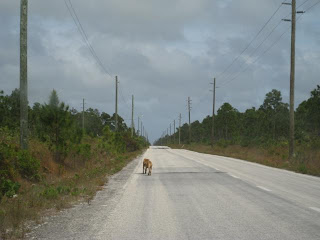
Other cruisers had told us that people on Grand Cay were "funny."
"Funny ha-ha or funny-peculiar?" we had asked.
"Well, they looked at us funny, when we walked down the street." We had to find out for ourselves. What we discovered was a quirky little island and lots of friendly people...no funny looks.
"Funny ha-ha or funny-peculiar?" we had asked.
"Well, they looked at us funny, when we walked down the street." We had to find out for ourselves. What we discovered was a quirky little island and lots of friendly people...no funny looks.
Entering the shallow harbor for the first time was a tricky enterprise, again, because of shallow water and current, but there were a few landmarks and other boats heading in and out to help us navigate.

We tried calling the marina owner, Rosie, who is a big guy and uses a call sign of "Love Train," but we got no answer. The marina docks didn’t seem to have enough draft for our sailboat, so we anchored near a few other cruising boats. The holding was a bit iffy, but the weather was settled and the harbor well-protected.
We set about to explore this little settlement, the farthest north, in the Bahamas. Grand Cay was settled because of its proximity to the deep waters of the Atlantic and the beautiful coral reefs just off its northern shore and it still reflects the maritime heritage. Hundreds of fishing boats were tucked into the many coves and creeks that surround the harbor of Grand Cay.
We set about to explore this little settlement, the farthest north, in the Bahamas. Grand Cay was settled because of its proximity to the deep waters of the Atlantic and the beautiful coral reefs just off its northern shore and it still reflects the maritime heritage. Hundreds of fishing boats were tucked into the many coves and creeks that surround the harbor of Grand Cay.

The closing of a resort at nearby Walker's Cay left many men here unemployed. Although playing pool in the local pubs seemed to be a major pastime for some of the young men, a number of the non-fishing men have taken to commuting weekdays to Freeport for employment. There is also quite a bit of pleasure diving here, as some say the reefs are the most beautiful in the Caribbean.
We strolled the narrow streets. The settlement is one of contrasts. Near the center of town is a dead mangrove swamp where trash and derelict boats languish in the brownish muck, and there are signs of gang-style graffiti on some of the abandoned buildings.

Yet, new houses are being built, there are several quaint churches and a lovely school where Bahamian youngsters laugh and learn in spic and span gold and green uniforms.
Friendly ladies offer bread, and other home-made goodies for sale. People strolling the streets, waved and greeted us with genuine friendliness. We traipsed from one end of the island to the other, and no one looked at us funny!
 I was particularly delighted by a toddler whom I spotted walking up a hill with her grandmother. She was obviously very proud of her walking prowess. We stopped to chat with Tanesha and her grandma. By the end of our little visit, she gave me a big hug and kiss!
I was particularly delighted by a toddler whom I spotted walking up a hill with her grandmother. She was obviously very proud of her walking prowess. We stopped to chat with Tanesha and her grandma. By the end of our little visit, she gave me a big hug and kiss! Tanesha and Grandma helped us find the local ice cream store and we treated ourselves to the last of the shop’s ice cream before we returned to Nimue.
To top off our visit to the Grand Cays, we went ashore for a lobster dinner at Rosie’s Place, the marina restaurant. Though we were the only customers that night, the lobster was plentiful and succulent.
To top off our visit to the Grand Cays, we went ashore for a lobster dinner at Rosie’s Place, the marina restaurant. Though we were the only customers that night, the lobster was plentiful and succulent.
All in all, our brief stop at Grand was a charming end to our stay in the Abacos. The next morning we headed southwest to Mangrove Cay on our way home.












































